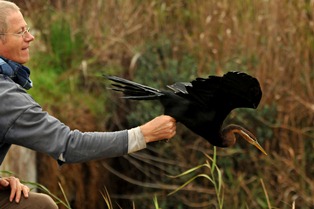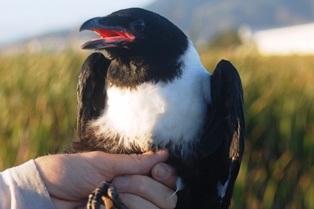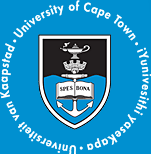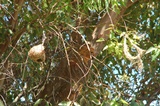This year the aim of the ringing was to continue recapturing as many weavers as possible, including those that had been ringed as weaver chicks). At the same time much ongoing data was obtained for survival and movements of weavers and other species on the Cape Peninsula. The ringing effort was less than in 2010. 38 species were caught, with a total of 1276 ringed and 308 recaptured (these totals do not include ringing by Sally, Felicity and others). A full species list of captures on the Cape Peninsula is given in Table 2 below (see also totals for 2008, 2009 and 2010. A photo gallery showing bird ringing events in the Cape Town area may be viewed here. To join bird ringing events in Cape Town, check dates on this calendar.
Ringing highlights


Left: adult African Darter (photo: Elsa Bussiere); Right: Pied Crow juvenile (photo: Gabriel Jamie)
Weaver summary
The weavers caught were lower than 2010 due to less effort. The recapture rate for Southern Masked Weavers was up (also that of Yellow Bishops but in this case the reason is due to lower new birds being caught).| Table 1 | 2009 | 2010 | 2011 | |||
| Species | Ringed | % Retrap | Ringed | % Retrap | Ringed | % Retrap |
| Cape Weaver | 625 | 20.6% | 626 | 17.1% | 209 | 18.2% |
| Southern Masked Weaver | 564 | 19.0% | 473 | 22.2% | 302 | 30.5% |
| Southern Red Bishop | 168 | 12.5% | 301 | 17.6% | 164 | 14.6% |
| Yellow Bishop | 18 | 22.2% | 79 | 17.7% | 15 | 73.3% |
Table 2: Species list of captures on the Cape Peninsula, 2011
The top four species ringed were Southern Masked Weaver, Cape Weaver, Southern Red Bishop and Common Waxbill. The highest recapture rate (where at least 10 birds were ringed) was for African Sedge Warbler, and then Yellow Bishop.| Species | English | Latin | Ring | Retr | % |
| 52 | Darter | Anhinga melanogaster | 1 | 0.0 | |
| 67 | Little Bittern | Ixobrychus minutus | 1 | 0.0 | |
| 238 | Threebanded Plover | Charadrius tricollaris | 1 | 1 | 100.0 |
| 275 | Spotted Dikkop | Burhinus capensis | 1 | 1 | 100.0 |
| 289 | Hartlaub's Gull | Larus hartlaubii | 0 | n/a | |
| 314 | Redeyed Dove | Streptopelia semitorquata | 5 | 0.0 | |
| 316 | Cape Turtle Dove | Streptopelia capicola | 2 | 0.0 | |
| 317 | Laughing Dove | Streptopelia senegalensis | 1 | 0.0 | |
| 394 | Pied Kingfisher | Ceryle rudis | 1 | 0.0 | |
| 397 | Malachite Kingfisher | Alcedo cristata | 14 | 6 | 42.9 |
| 493 | Barn Swallow | Hirundo rustica | 2 | 0.0 | |
| 495 | Whitethroated Swallow | Hirundo albigularis | 4 | 0.0 | |
| 509 | Brownthroated Martin | Riparia paludicola | 6 | 0.0 | |
| 522 | Pied Crow | Corvus albus | 1 | 0.0 | |
| 543 | Cape Bulbul | Pycnonotus capensis | 24 | 3 | 12.5 |
| 581 | Cape Robin | Cossypha caffra | 4 | 3 | 75.0 |
| 604 | Cape Reed Warbler | Acrocephalus gracilirostris | 81 | 35 | 43.2 |
| 606 | African Marsh Warbler | Acrocephalus baeticatus | 23 | 1 | 4.3 |
| 609 | African Sedge Warbler | Bradypterus baboecala | 15 | 11 | 73.3 |
| 646 | Levaillant's Cisticola | Cisticola tinniens | 86 | 42 | 48.8 |
| 686 | Cape Wagtail | Motacilla capensis | 3 | 0.0 | |
| 692 | Grassveld Pipit | Anthus cinnamomeus | 3 | 1 | 33.3 |
| 703 | Orangethroated Longclaw | Macronyx capensis | 3 | 0.0 | |
| 707 | Fiscal Shrike | Lanius collaris | 3 | 2 | 66.7 |
| 722 | Bokmakierie | Telophorus zeylonus | 2 | 0.0 | |
| 733 | European Starling | Sturnus vulgaris | 2 | 0.0 | |
| 760 | Lesser Doublecollared Sunbird | Nectarinia chalybea | 16 | 3 | 18.8 |
| 786 | Cape Sparrow | Passer melanurus | 31 | 0.0 | |
| 799 | Cape Weaver | Ploceus capensis | 209 | 38 | 18.2 |
| 803 | Southern Masked Weaver | Ploceus velatus | 302 | 92 | 30.5 |
| 808 | Southern Red Bishop | Euplectes orix | 164 | 24 | 14.6 |
| 810 | Yellow Bishop | Euplectes capensis | 15 | 11 | 73.3 |
| 843 | Common Waxbill | Estrilda astrild | 148 | 23 | 15.5 |
| 846 | Pintailed Whydah | Vidua macroura | 6 | 0.0 | |
| 857 | Cape Canary | Serinus canicollis | 2 | 0.0 | |
| 1172 | Cape White-eye (split) | Zosterops capensis | 82 | 4 | 4.9 |
| 4139 | Karoo Prinia (split) | Prinia maculosa | 12 | 7 | 58.3 |
| Totals | 1276 | 308 | 24.1 |
Acknowledgements
Thanks to the following for helping with ringing during 2011: Alan Lee, Alex Antrobus, Barry & Sue Schultz, Calvin & Damian Gibbs, Carol Milan, Colin Jackson, Craig Nattrass, Dane, Dalton Gibbs, Elsa & Matthew, Felicity Ellmore, Flo, Gabriel, Hashradah R, Joel Avni, Kate England, Kate England, Kate Goodale, Kate Robinson, Kirsten, Lisa Nupen, Loutjie, Lynne Roscoe, Maya Stauch & Kenilworth Race Course staff & students, Petra, Robyn & Adel Kadis, Rondevlei staff/students, Shane, Sally Hofmeyr, Sharon Okanga, Susie Cunningham, Tandy Oschadleus
Funding was previously gratefully received from the African Bird Club Conservation Fund and the Cape Tercentenary Foundation
to study natal dispersal in weavers.










